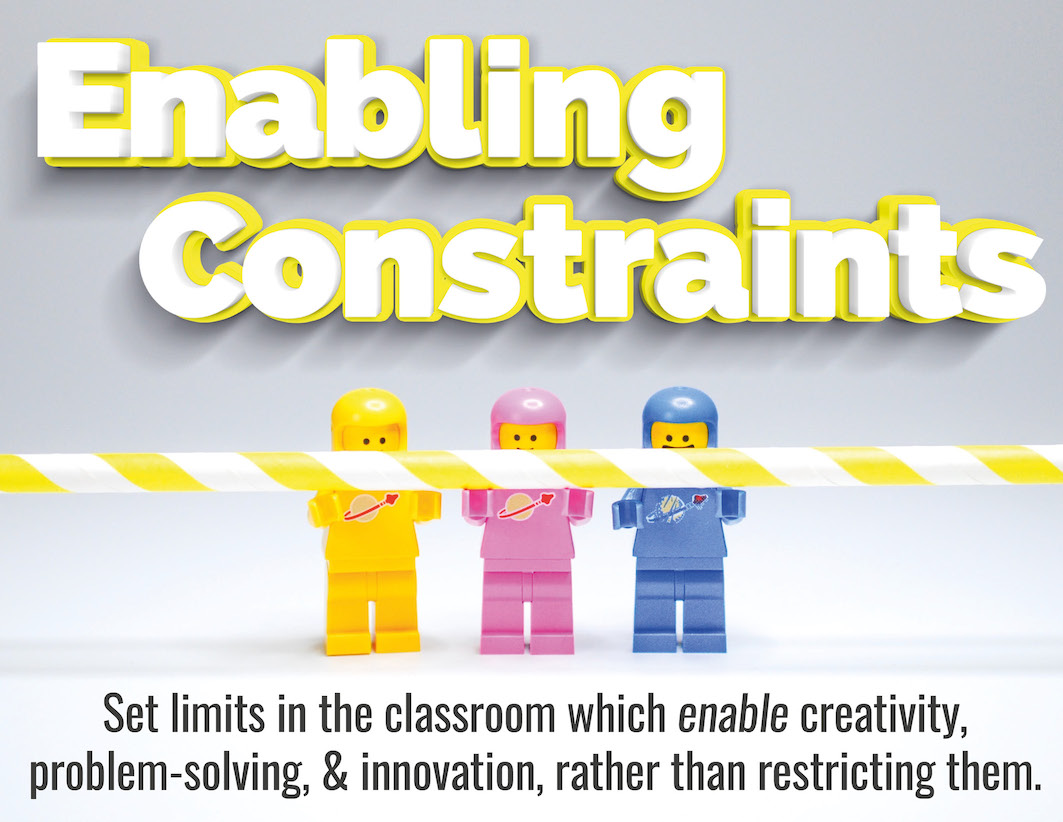How to Set Boundaries which Enable Creativity In the Classroom

Imagine I said, write a story. That’s it: no restrictions.
Is that freeing, or daunting?
Now imagine I told you: Write a story; but you must take a real-life event from your past, and write it as though it were a fairytale.
Does that feel more doable?
If you’re like me, the restricting conditions don’t make the task feel limiting or uninspiring – quite the opposite. They give me a starting point; some intriguing boundaries to work within, and a challenge to overcome.
That is what is meant by the term enabling constraints. It means setting limitations or boundaries in a way that enhances creativity, problem-solving, and innovation, rather than restricting them. It might sound counterintuitive at first, but these constraints can serve as powerful catalysts for ingenuity and critical thinking and help enable creativity in the classroom.
In the context of teaching, enabling constraints are used to guide and inspire students’ learning experiences. Instead of dictating rigid rules or simply providing all the answers, they help create a framework of boundaries within which students can be free to explore and discover knowledge independently.
Of course, if we set too many constraints (or they’re too specific), they can become restrictive and inhibiting. Think back to my opening example: if I said that your story had to be exactly 600 words, had to have an ogre, had to be set underwater, and had to center around the theme of friendship: all that might stifle your creativity, and feel oppressively limiting. That is where constraints tip over from being positive and enabling, to being negative and restrictive. We need to find a positive balance.
Examples of Enabling Constraints in the ELA Classroom:
As you will see from the following examples, each one takes a common task and provides students with boundaries to work within, constraints which enable them to exercise their own creativity, while also building key skills.
- Found Poetry Project: Students create a poem using words and phrases found in a specific text, promoting close reading and creative expression, with an accessible point to jump off from.
- Character Monologues: Students write a monologue from the perspective of a character in a novel or play, encouraging them to delve into the character’s mindset and emotions, while exercising their own imaginative skills.
- Flash Fiction Challenge: Students write a complete story – about anything of interest – in only 100 words, forcing them to be concise and creative in their storytelling.
- Book Cover Redesign: Students redesign book covers to represent the theme and essence of a novel, promoting visual literacy and interpretation, all while working with a known, given text.
- Debate with Assigned Positions: Students participate in a debate where they argue an opinion provided to them, perhaps different from their own. This helps develop empathy, but within the bounds of a given viewpoint.
- Literary Analysis with Limited Quotes: For a literature analysis essay, students are given specific quotes to analyze, encouraging them to build arguments around textual evidence.
- Creative Writing with Random Prompts: Students are given random objects, images, or phrases and are challenged to incorporate them into a creative writing piece, promoting adaptability and imagination.
- Scriptwriting for Short Plays: Working in groups, students write short plays based on a novel you’re studying, learning the art of dialogue and effective storytelling.
Why are enabling constraints effective in the classroom:
- Enable Creativity in the Classroom: By presenting students with problems or projects that have certain limitations, you can stimulate creative thinking. Students are forced to think outside the box and develop innovative solutions within the given boundaries.
- Fostering Resourcefulness: Enabling constraints push students to be resourceful. When they encounter limitations, they are motivated to find alternative approaches and use available resources effectively.
- Promoting Critical Thinking: When working within constraints, students must analyze the situation, identify the most critical aspects, and make informed decisions. This cultivates their critical thinking skills.
- Emphasizing Prioritization: Constraints force students to prioritize and focus on what truly matters. It teaches them how to manage their time and efforts efficiently.
- Building Resilience: Overcoming challenges posed by constraints builds resilience and perseverance. Students learn that setbacks are a natural part of the learning process and that they can learn from them.
- Enhancing Collaboration: Enabling constraints can encourage collaboration among students. As they work together to tackle complex problems, they learn from one another and pool their strengths.
- Real-World Relevance: Many real-world situations involve constraints—whether it’s limited resources, time constraints, or specific guidelines. By learning within enabling constraints, students prepare for practical scenarios they may encounter in the future.
So next time you set students a task, ask yourself: Are the constraints of this activity going to stifle creativity, or will they encourage innovation, enabling students to thrive?
Looking for engaging resources which enable creativity in the classroom? Check out my resources HERE.
